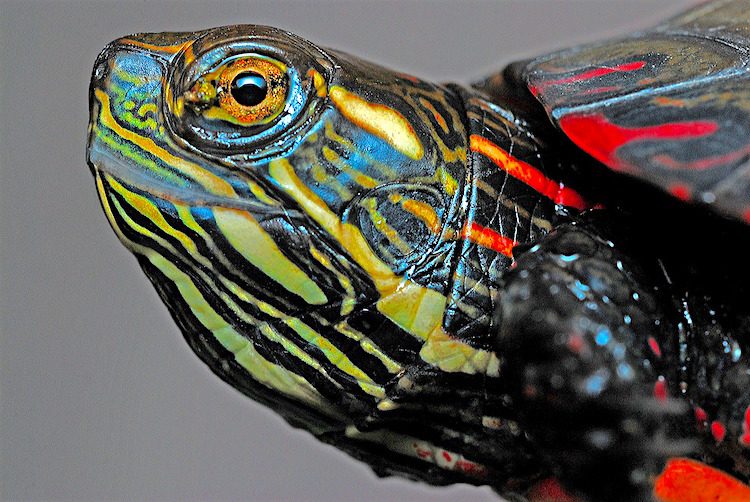Painted turtles are not suitable pets for children as they do not enjoy being held and prefer to live alone. Proper care, including providing special lighting and knowing the specific needs of the species, is essential to maintain their health and prevent diseases like metabolic bone disease.
Turtles taken from the wild may not adjust well to captivity and can experience stress, leading to a lack of appetite and increased vulnerability to illnesses. Additionally, turtles, including painted turtles, can carry Salmonella germs on their bodies, which can be transferred to humans upon contact.
Therefore, it is important to handle them with caution. Overall, painted turtles can be a great option for pet owners with the right knowledge and commitment to their care.
Introduction To Painted Turtles As Pets
Discover the world of Painted Turtles as pets and learn about their unique care needs. Before getting one, ensure you understand their species requirements and the necessary accommodations to provide a suitable home for these fascinating reptiles.
Overview Of Painted Turtles
Painted turtles are popular pets known for their striking appearance and fascinating behaviors. These turtles are native to North America and are characterized by their colorful shell, which showcases intricate patterns and vibrant hues. They are relatively small in size, with adults typically reaching around 5-7 inches in length. Painted turtles are semi-aquatic creatures, meaning they spend a significant amount of time both in water and on land. They are excellent swimmers and have a keen sense of navigation, making them captivating pets to observe.Advantages And Considerations
There are several advantages to owning a painted turtle as a pet. Firstly, they are relatively low-maintenance animals, making them ideal for first-time reptile owners or those with busy lifestyles. Painted turtles primarily require a spacious enclosure with both water and land areas, proper heating and UVB lighting, and a nutritionally balanced diet. These turtles are resilient and can adapt well to a variety of environments, making them fairly easy to care for. However, it is important to consider a few key factors before deciding to bring a painted turtle into your home. Firstly, painted turtles have a long lifespan, often living for 20-30 years or even longer with proper care. Therefore, potential owners should be prepared for a long-term commitment. Additionally, painted turtles require adequate space to swim and bask, so providing a suitable enclosure is crucial. It is important to research and understand the specific needs of the painted turtle species you are interested in before bringing one home.Common Painted Turtle Species
There are several species of painted turtles commonly kept as pets. Some of the most popular species include: – Eastern Painted Turtle (Chrysemys picta picta): This species is native to the eastern regions of North America and is known for its vibrant red and yellow markings on its shell. Eastern painted turtles are relatively small in size and have a friendly and curious demeanor. – Midland Painted Turtle (Chrysemys picta marginata): Found in the central regions of North America, the midland painted turtle has a dark-colored shell with bright yellow markings. They are known for their friendly nature and adaptability to various habitats. – Western Painted Turtle (Chrysemys picta bellii): Native to the western parts of North America, the western painted turtle has a beautiful shell pattern with red and yellow markings. They are active turtles and enjoy basking in the sun. Each painted turtle species has its own unique characteristics, care requirements, and temperament. It is important to choose a species that aligns with your preferences and lifestyle, and to provide the appropriate care to ensure the health and well-being of your painted turtle pet. In conclusion, painted turtles make fantastic pets for reptile enthusiasts of all experience levels. With their stunning appearance, interesting behaviors, and relatively low-maintenance care requirements, these turtles can bring joy and fascination to their owners. However, it is crucial to do thorough research and prepare a suitable habitat before bringing a painted turtle into your home. By understanding their specific needs and providing a nurturing environment, you can ensure a happy and fulfilling life for your painted turtle companion.
Credit: www.petful.com
Caring For Painted Turtles
Caring for painted turtles as pets involves providing a suitable enclosure, a proper diet, and ensuring their overall health and well-being. It is important to research the specific care requirements of painted turtles before bringing one home.
Housing And Enclosure Design
When it comes to housing and enclosure design for painted turtles, it is crucial to provide a suitable environment that mimics their natural habitat. A spacious and secure enclosure is essential, as painted turtles require ample space to swim and bask. The enclosure should have both a water area and a dry land area to cater to their diverse needs.Key points for housing and enclosure design:
- Choose a tank or pond that is large enough to accommodate the size of your turtle.
- Ensure that the water in the enclosure is deep enough for swimming, but shallow enough for them to easily reach the surface for breathing.
- Include a basking area with a heat lamp to provide the necessary warmth for their well-being.
- Use a substrate at the bottom of the tank that is easy to clean and maintain, such as smooth rocks or sand.
- Regularly clean and filter the water to maintain optimal hygiene for your turtle.
Proper Diet And Feeding
A proper diet is crucial for the health and well-being of painted turtles. These omnivorous creatures require a balanced mix of both animal protein and vegetation. The diet should consist of commercial turtle pellets, fresh leafy greens, vegetables, and occasional live or frozen prey items.Key points for proper diet and feeding:
- Offer a variety of foods to ensure a well-rounded diet for your painted turtle.
- Avoid overfeeding and monitor their food intake to prevent obesity.
- Provide calcium and vitamin supplements to promote healthy bone growth.
- Ensure that your turtle has access to clean and chlorine-free water for drinking and swimming.
- Remove any uneaten food to maintain the cleanliness of the enclosure.
Handling And Interaction
While painted turtles are not known for being overly social or interactive pets, they can still enjoy some gentle handling and interaction. It is important to handle them with care and respect their boundaries to avoid causing stress or injury.Key points for handling and interaction:
- Wash your hands before and after handling your painted turtle to prevent the spread of bacteria.
- Support their body properly while handling to avoid any undue stress on their limbs or shell.
- Limit handling sessions to short durations, as prolonged handling can cause stress and discomfort for the turtle.
- Observe your turtle’s body language and behavior, and if they show signs of distress or discomfort, gently return them to their enclosure.
Health And Hardiness
Painted turtles are generally hardy and resilient pets, but it is still essential to monitor their health and provide proper care to prevent any potential health issues. Regular check-ups with a reptile veterinarian are recommended to ensure their overall well-being.Key points for health and hardiness:
- Monitor your turtle for any signs of illness, such as loss of appetite, lethargy, or abnormal behavior.
- Provide proper UVB lighting to support their calcium absorption and prevent metabolic bone diseases.
- Keep the enclosure clean and maintain appropriate temperature and humidity levels.
- Prevent exposure to harmful chemicals or toxins that may pose a risk to their health.
- If you notice any concerning symptoms, consult a reptile veterinarian for guidance and treatment.
Tips For Choosing And Acquiring Painted Turtles
Looking to acquire a painted turtle as a pet? Make sure to research and understand the specific care needs and requirements of these reptiles before bringing one home. Keep in mind that turtles may not enjoy being held and can be more suitable for older owners who can provide the necessary care.
Finding Painted Turtles
When it comes to choosing and acquiring painted turtles as pets, finding a reliable source is crucial. There are several places you can look to find these lovely creatures:
- Pet Stores: Many pet stores carry painted turtles, but it’s important to do your research and ensure they are reputable and knowledgeable about turtle care.
- Reptile Expos: Reptile expos are events where breeders and enthusiasts come together to showcase and sell reptiles, including painted turtles. This can be a great place to find a wide variety of turtles and speak directly with knowledgeable breeders.
- Online Classifieds and Websites: Online classifieds such as Craigslist or pet-specific websites like ReptileCity.com can also be a good resource for finding painted turtles. However, exercise caution and thoroughly research the seller before making a purchase.
Considerations For Captive-bred Versus Wild Turtles
When acquiring a painted turtle, you’ll come across both captive-bred and wild-caught options. It’s important to understand the differences before making your decision:
| Captive-Bred Turtles | Wild-Caught Turtles |
|---|---|
|
|
Legal And Ethical Considerations
Before acquiring a painted turtle, it is essential to consider the legal and ethical aspects:
- In some areas, it may be illegal to own a painted turtle as a pet. Check your local laws and regulations before making a purchase.
- If you choose to acquire a wild-caught turtle, keep in mind that this practice can harm natural habitats and contribute to population decline.
- Consider adoption or rescue options as an alternative to obtaining a turtle from the wild or commercial sources.
By considering these factors and making informed decisions, you can ensure the well-being of the painted turtles you choose as pets, while also promoting ethical and responsible pet ownership.

Credit: www.youtube.com

Credit: www.petmd.com
Frequently Asked Questions Of Painted Turtles As Pets
Do Painted Turtles Like To Be Held?
Painted turtles do not like to be held as they are solitary animals and can become boring pets for children. It is important to know their species and proper care before acquiring a pet turtle to prevent health issues like metabolic bone disease.
Wild turtles should not be kept as pets as it causes stress and negatively impacts their health. Turtles may carry Salmonella germs, so it is important to practice good hygiene after touching them.
Can You Keep A Wild Painted Turtle As A Pet?
No, it is not recommended to keep a wild painted turtle as a pet. Wild turtles are not used to living in captivity and it can cause them stress and health issues. Additionally, handling wild turtles can spread germs like Salmonella.
It’s important to choose the right species and understand their care needs before getting a pet turtle.
What Is The Lifespan Of A Painted Turtle In Captivity?
The lifespan of a painted turtle in captivity is around 25-30 years.
Are Painted Turtles Safe To Touch?
Painted turtles may carry Salmonella germs, even if they look clean and healthy. Touching them can spread these germs to hands and clothing. It’s important to know the care requirements and potential health risks before owning a pet turtle. (42 words)
Conclusion
Overall, painted turtles can make great pets for both beginners and experienced hobbyists. Their docile nature and interesting appearance make them appealing to many. However, it is important to understand the specific care requirements for painted turtles before bringing them into your home.
It is crucial to provide the right enclosure, adequate lighting, and a proper diet to ensure their health and well-being. Additionally, it is essential to handle them with care and to be aware of the potential health risks associated with touching turtles.
By taking the time to educate yourself and provide proper care, painted turtles can be a rewarding and enjoyable pet to have.

